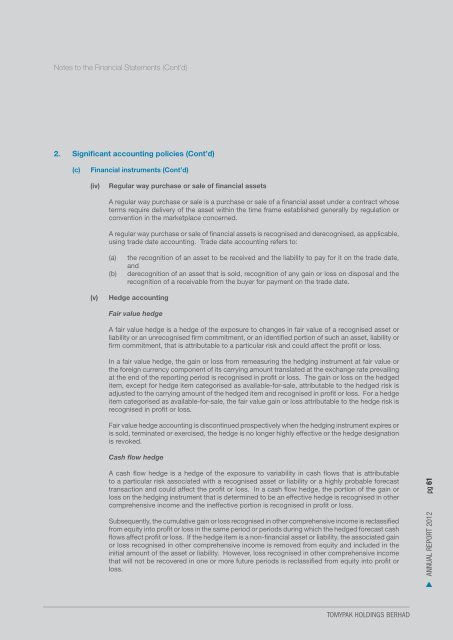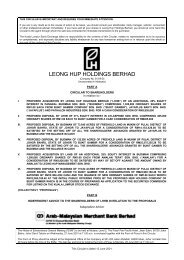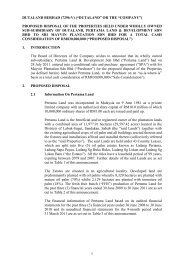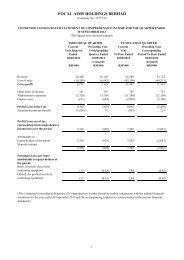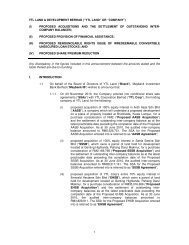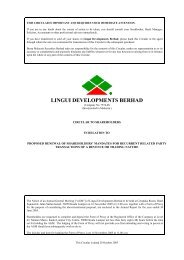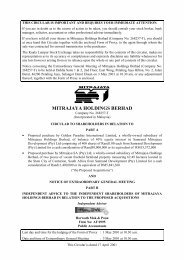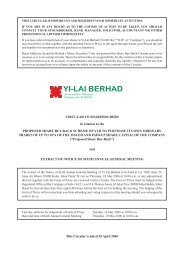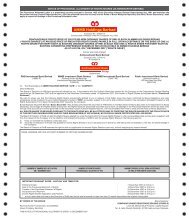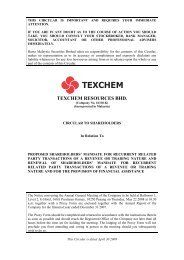tomypak holdings berhad annual report 2012 - Announcements ...
tomypak holdings berhad annual report 2012 - Announcements ...
tomypak holdings berhad annual report 2012 - Announcements ...
You also want an ePaper? Increase the reach of your titles
YUMPU automatically turns print PDFs into web optimized ePapers that Google loves.
Notes to the Financial Statements (Cont’d)<br />
2. Significant accounting policies (Cont’d)<br />
(c) Financial instruments (Cont’d)<br />
(iv) Regular way purchase or sale of financial assets<br />
A regular way purchase or sale is a purchase or sale of a financial asset under a contract whose<br />
terms require delivery of the asset within the time frame established generally by regulation or<br />
convention in the marketplace concerned.<br />
A regular way purchase or sale of financial assets is recognised and derecognised, as applicable,<br />
using trade date accounting. Trade date accounting refers to:<br />
(a) the recognition of an asset to be received and the liability to pay for it on the trade date,<br />
and<br />
(b) derecognition of an asset that is sold, recognition of any gain or loss on disposal and the<br />
recognition of a receivable from the buyer for payment on the trade date.<br />
(v) Hedge accounting<br />
Fair value hedge<br />
A fair value hedge is a hedge of the exposure to changes in fair value of a recognised asset or<br />
liability or an unrecognised firm commitment, or an identified portion of such an asset, liability or<br />
firm commitment, that is attributable to a particular risk and could affect the profit or loss.<br />
In a fair value hedge, the gain or loss from remeasuring the hedging instrument at fair value or<br />
the foreign currency component of its carrying amount translated at the exchange rate prevailing<br />
at the end of the <strong>report</strong>ing period is recognised in profit or loss. The gain or loss on the hedged<br />
item, except for hedge item categorised as available-for-sale, attributable to the hedged risk is<br />
adjusted to the carrying amount of the hedged item and recognised in profit or loss. For a hedge<br />
item categorised as available-for-sale, the fair value gain or loss attributable to the hedge risk is<br />
recognised in profit or loss.<br />
Fair value hedge accounting is discontinued prospectively when the hedging instrument expires or<br />
is sold, terminated or exercised, the hedge is no longer highly effective or the hedge designation<br />
is revoked.<br />
Cash flow hedge<br />
A cash flow hedge is a hedge of the exposure to variability in cash flows that is attributable<br />
to a particular risk associated with a recognised asset or liability or a highly probable forecast<br />
transaction and could affect the profit or loss. In a cash flow hedge, the portion of the gain or<br />
loss on the hedging instrument that is determined to be an effective hedge is recognised in other<br />
comprehensive income and the ineffective portion is recognised in profit or loss.<br />
Subsequently, the cumulative gain or loss recognised in other comprehensive income is reclassified<br />
from equity into profit or loss in the same period or periods during which the hedged forecast cash<br />
flows affect profit or loss. If the hedge item is a non-financial asset or liability, the associated gain<br />
or loss recognised in other comprehensive income is removed from equity and included in the<br />
initial amount of the asset or liability. However, loss recognised in other comprehensive income<br />
that will not be recovered in one or more future periods is reclassified from equity into profit or<br />
loss.<br />
TOMYPAK HOLDINGS BERHAD<br />
ANNUAL REPORT <strong>2012</strong> pg 61<br />
▲


